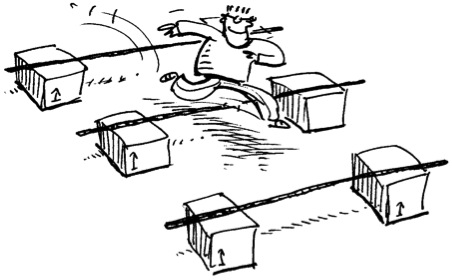Undergraduate perspective on Sports & Exercise Medicine – a BJSM blog series
By Liam West (@Liam_West)
Sports and Exercise Medicine (SEM) in the United Kingdom is rapidly gaining medical students’ recognition as a potentially attractive career. However, several barriers exist facing students interested in SEM that they may need to overcome before leaping into the specialty!
 Current state of play for budding SEMer’s!
Current state of play for budding SEMer’s!
The Undergraduate Medical Curricula at most medical schools does not include any formal SEM education. Instead there is an emphasis at the undergraduate level on disease not health. Undergraduate education fails to mirror the current shift in the NHS, and indeed globally, towards using physical activity (PA) as a preventative medicine and treatment modality. Richard Weiler et al. highlighted the failure of medical schools to equip ‘tomorrow’s doctors’ with the basic knowledge, confidence and skills to promote PA to their patients.
Role models and mentors are few and far between in SEM. Medical students do not encounter SEM professionals during normal placements. We are therefore forced to actively seek out these individuals to gain insights as to the life of an SEM practioner.
Shadowing experience is limited in both sports medicine and exercise medicine. In conjunction with the lack of mentors in SEM, it is tough to find a suitable environment to learn, observe and participate. In the elite sporting environment, frequently complicated insurance & trust issues with administrators or coaches make shadowing impossible. With exercise medicine in its infancy in the UK, opportunities to experience this aspect of SEM are rare.
The pathway into SEM is still unclear to most medical students; should we take the gamble of following the new SEM training pathway or stick to more traditional routes such as GP or Surgery with a specialist interest in SEM?
There is a real fear of job security amongst medical students considering SEM as a career; will there be enough registrar posts to accommodate everyone? Will there be sufficient funding to sustain a central role for SEM in the NHS? Will SEM gain recognition from more traditional specialities and become a cornerstone of disease prevention and treatment?
Overcoming these challenges
Despite the bleak picture painted above, SEM proves to be an immensely enjoyable and rewarding vocation. Once medical students identify barriers, they may be proactive and overcome them using their initiative.
Join a regional Society. At several universities across the UK, SEM Societies have been formed to formally bridge the gap between the dearth of SEM education at undergraduate level and postgraduate course in SEM. They run regular evening talks and often help to arrange shadowing experience or involvement in SEM related research.
Undergraduate Sports & Exercise Medicine Society. USEMS is a new society that will be officially launched this year and will represent all medical schools in the UK. It will centralise all information relevant to students interested in SEM, whilst also helping new regional societies to be created. USEMS will help students gain shadowing experience and provide education at an appropriate level. We will post a blog once USEMS is launched – watch this space!
Organise elective and course placements in SEM. Students should try to tailor their student selected modules (SSM) and elective placements to incorporate SEM so that they can get experience in the field whilst forming relationships with SEM professionals. Students can also undertake intercalated degrees in SEM or sports science to further their interest.
Listen to podcasts and contribute to this blog. Students shouldn’t get intimidated by their lack of knowledge in SEM and there is much on BJSM that is applicable. Reading the BJSM journal will help you to keep up to date on critical & emerging subject / research areas in the field – many of which we can get involved in. Listening to podcasts such as the entries from Mike Loosemore and Steven Blair not only provides much food for thought but also gives insights into the future pathway SEM will be treading. Watching media, such as the 23.5 hours video from Mike Evans can be hugely inspirational! Also, you are encouraged to contribute to this blog and get your name noticed!
Network, Network, Network! A crucial step for interested undergraduate students looking for a career in SEM is to network with as many SEM professionals that they can. In doing so many doors will open for you and you must seize these opportunities! Attending conferences is a great way of achieving this, such as the upcoming BASEM Conference in November or specific undergraduate SEM conferences like the Cardiff Post-Olympic SEM Conference on December 15th 2012 (blog to follow).
Is this situation the same across the UK or in other countries? Can you offer advice and / or resources to students or your peers (if you are a medical student)?\
I am interested to hear from you to raise awareness and identify critical issues related to undergraduate SEM.
For blog submissions, email: liamwestsem@hotmail.co.uk
*************************************************************
Liam West is a final year medical student at Cardiff University (Wales). He is an Associate Editor for BJSM and the co-ordinator of the “The Undergraduate perspective on Sports & Exercise Medicine” twice-monthly blog series. He is the founder and President of Cardiff Sports and Exercise Medicine Society (CSEMS), and organised the Cardiff SEM Conference 2012. He sits on the Council of Sports Medicine for the Royal Society of Medicine as Student Representative. He is currently helping to rewrite the undergraduate medical course at his University to include more teaching on the use of physical activity as a preventative medicine and treatment modality for non-communicable diseases.